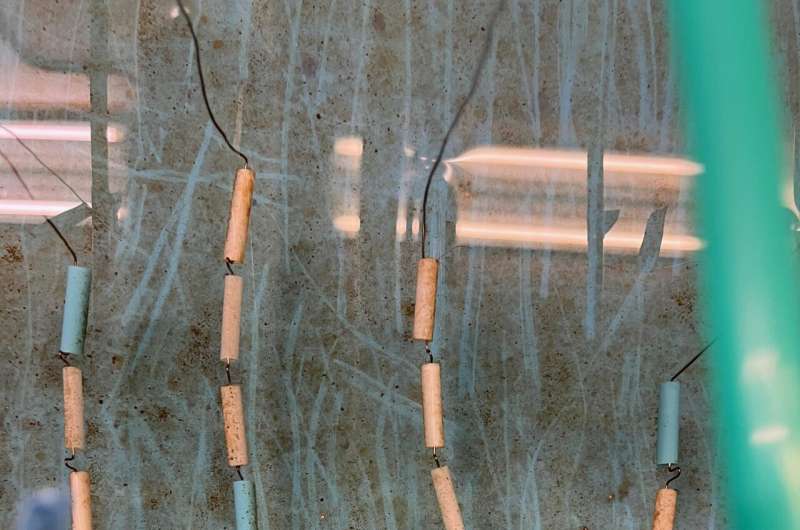Degradation of straws made from different types of materials were observed for 16 weeks at WHOI's Environmental Systems Lab. The tanks the straws were kept in had a continuous flow of ocean water from Martha's Vineyard Sound. Credit: Bryan James/Woods Hole Oceanographic Institution
Straws are one of the most common plastic waste products found on coastlines. As more and more plastic products are being produced, consumed, and disposed of, scientists and manufacturers are developing alternative materials that work equally as well, and don't contribute to persistent plastic pollution in the environment.
But not all plastics are created the same—different manufacturers have different formulations of base polymers—such as polylactic acid (PLA) and polypropylene (PP)—and chemical additives. That means different plastic formulations behave differently in the environment and break down in the ocean at different rates.
There are new materials out in the market that move away from petroleum-derived products—like cellulose diacetate (CDA), a polymer derived from wood pulp that is widely used in consumer goods—and Woods Hole Oceanographic Institution (WHOI) scientists have been working to quantify the environmental lifetimes of a wide range of plastic goods to answer the unresolved question, how long do straws last in the ocean?
In a new paper published in ACS Sustainable Chemistry & Engineering, WHOI scientists Collin Ward, Bryan James, Chris Reddy, and Yanchen Sun put different types of plastics and paper drinking straws head-to-head to see which degrade the fastest in the coastal ocean. They partnered with scientists from bioplastic manufacturing company Eastman.
"We lack a firm understanding of how long plastics last in the ocean, so we've been designing methods to measure how fast these materials degrade," Ward said. "It turns out, in this case, there are some bioplastic straws that actually degrade fairly quickly, which is good news."
Their approach involved suspending eight different types of straws in a tank of continuously flowing seawater from Martha's Vineyard Sound, Massachusetts. This method also controlled the temperature, light exposure, and other environmental variables to mimic the natural marine environment. All straws were monitored for signs of degradation over 16 weeks, and the microbial communities growing on the straws were characterized.
"My interest has been to understand the fate, persistence, and toxicity of plastic and how we can use that information to design next-generation materials that are better for people and the planet," James said. "We have the unique capability where we can bring the environment of the ocean on land in our tanks at the environmental systems laboratory. It gives us a very controlled environment with natural seawater."
They tested straws made of CDA, polyhydroxyalkanoates (PHA), paper, PLA, and PP. In the weeks the straws were submerged in the tanks, the CDA, PHA, and paper straws degraded by up to 50%, projecting environmental lifetimes of 10–20 months in the coastal ocean. The PLA and PP straws showed no measurable signs of degradation.
The scientists then compared two straws made from CDA—one a solid and the other a foam, both provided by Eastman. The straw made from foamed CDA was a prototype to see if increasing the surface area would accelerate breakdown. They found that the degradation rate of the foam straw was 184% faster than its solid counterpart, resulting in a shorter projected environmental lifetime than the paper straws.
More information: Bryan D. James et al, Strategies to Reduce the Environmental Lifetimes of Drinking Straws in the Coastal Ocean, ACS Sustainable Chemistry & Engineering (2024). DOI: 10.1021/acssuschemeng.3c07391
Collin P. Ward et al, To curb plastic pollution, industry and academia must unite, Nature (2024). DOI: 10.1038/d41586-024-00155-z
Journal information: ACS Sustainable Chemistry & Engineering , Nature
Provided by Woods Hole Oceanographic Institution





















